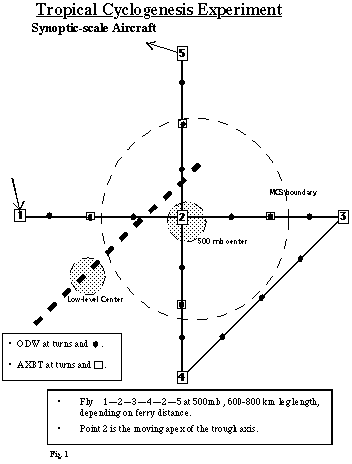
This document is divided into 3 sections:
This experiment is designed to study incipient tropical systems which may ultimately develop into TCs. The importance of this study is not limited to TC investigations. The proposed experiment should yield useful insight into the structure, growth and u ltimately the predictability of the systems responsible for the most tropical precipitation. The experiment focuses on features in the tropical atmosphere at several different levels in the vertical and on a wide range of spatial and temporal scales. Thes e include: 1) the development of a mid-level vortex associated with MCSs at 500-700 mb, 2) role of the mid-level easterly jet in enhancing cyclonic vorticity and producing squall lines and surges at 700 mb, 3) low-level vortex spin-up in response to south westerly surges and intense convection.
The synoptic-scale aircraft should be a NOAA P-3 or the jet. It will fly a figure-4 survey pattern at 500 mb (200 mb for the jet) centered on the MCS (Fig. 1), but extending as far along the cardinal directions as available aircraft range allows (nomina lly 800 km).
The approach leg should be east-west to facilitate location of the trough axis. Ideally, the diagonal leg should fall in the southeast quadrant, and the south-north leg should lie at an angle to the trough axis. This aircraft will dispense 3 or 4 omega-dr opwindsondes (ODWs) and airborne expendable bathythermographs (AXBTs) on each leg, including the diagonal, to map the MCS atmospheric and oceanic environment (particularly accurate sea-surface temperature determination). The main purpose of this pattern is to map the synoptic-scale circulation encompassing the mid-level vortex embedded in the MCS. The east and northeast legs should attempt to penetrate past the 700-mb jet into the Saharan Air Layer so that ODWs can resolve some of the vertical structure of these features at lower levels. The south and southwest legs should penetrate past the low-level southeasterly jet, if it exists, in order to resolve its vertical structure with ODWs. This aircraft should spend less than half its time under the anvil, but during that time it should collect microphysics observations and Doppler radar data using the fore/aft scanning technique (F/AST).
The mesoscale aircraft should be a Doppler-equipped NOAA P-3. It will fly rotating figure-4 pattern at 600 or 700 mb under the anvil of the MCS (Fig. 2).
The leg lengths will be 180-250 km, and the pattern will be approximately centered on the moving trough axis. The primary purpose of this aircraft is to collect Doppler radar data using F/AST throughout the mission in order to map the three-dimensional ki nematic structure of the MCS. It may dispense ODWs and collect microphysics data on a target of opportunity basis.
A variation on the basic two-plane mission would add a third low-level aircraft. This aircraft flies a "racetrack" pattern at 850 mb or 500 m, depending on the situation (Fig. 3).
If a USAF WC-130 is available, they could be requested to fly a low-level investigative mission with their standard "racetrack" or "alpha" pattern. When the low-level aircraft is a NOAA P-3, it would fly a "racetrack" pattern oriented normal to the tropic al wave trough axis. This P-3 should have the C-band scatterometer (C-SCAT) and the stepped-frequency microwave radiometer (SFMR) for determination of the surface wind field. A low-level wind field, at either the surface or 500 m is essential for comparis on with winds at upper levels in order to determine the vertical structure of the circulation features.
It would be highly desirable to construct on-board radar composites using the workstation for the purpose of properly positioning both aircraft with respect to the MCS. ODWs should be transmitted to NHC and NMC for inclusion in synoptic analyses.